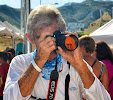
As I jumped from the swimstep into the crystal blue water, I wasn't sure what to expect.
One of the most memorable two weeks I have ever spent in Baja was to study and film the feeding behavior of (primarily) billfish offshore near Magdalena Bay. Instead of focusing on catching fish, my assignment was to find the schools of bait so the teams of scientists, divers and photographers could film the feeding behavior.
My trip began with a BBC crew filming the Open Ocean segment for the Blue Planet series followed the second week by Dr. Guy Harvey, scientist, explorer, artist, diver and conservationist, along with his crew which included fisheries biologist and marine wildlife photographer, William Boyce. It was on this second trip that I became part of the underwater adventure.
Finding the bait schools for the crews was easy. But figuring out what stage the balling bait was in, was more difficult. There was the formation, the middle and the conclusion.
In the formation stage, the ball…while well-formed…would be seen racing across the surface with billfish in hot pursuit. The billfish would encircle the ball and force it to mill in one place.
Once that was accomplished, the action slowed dramatically. Many gamefish species, striped marlin, sailfish, dorado, tuna, wahoo and even sea lions and whales, would join in the fray.
This was the stage that the divers went into the water, along with their camera and equipment…right in the middle of the gamefish. Once underwater, the divers observed that all of the different species seemed to feed in an orderly fashion. The competition which one would normally expect among the species was absent. The fish each seemed to take a turn at the dinner table!
This activity would continue until a large school of at least 5,000 sardines was whittled down to less than a hundred. Some of the schools would last as long as three hours before they were almost completely devoured. The schooling instinct so evident up to this point would suddenly be discarded and all of the remaining bait would take off in different directions with fish chasing them.
With Guy Harvey and Bill Boyce encouraging me, I decided to take a look underwater for myself. They brought out extra equipment and helped me get suited up. On the next event after the team had been in the water for thirty minutes, they motioned for me to come in for a look. I jumped from the swimstep into the crystal blue water, and made my way out the short distance to where the team was filming a brilliantly lighted marlin slowly circling a school of sardines. As the bait ball changed directions, the light from the sun reflected off the sides of the sardines, like neon lights switching on and off.
Though the striped marlin was the predominant feeders, several dorado with the unmistakable golden, green and blue colors could be seen in the mix. Suddenly, out of the shadows came a dark almost black silhouette with a much larger dorsal completely extended swimming straight toward the bait. It was a large sailfish! As it swam into the circling group, I would have expected some negative reaction from the other fish, but it was accepted and joined in the feeding process. I was so intrigued with the sights, I lost track of time and when Boyce tapped me on the shoulder and pointed in the direction of the boat, I had been in the water almost thirty minutes.
When I popped to the surface to get my bearing I was now thirty yards from the boat. After years of not diving, I will admit it was a bit of a physical challenge to make my way back.
Both weeks provided an education into the underwater feeding behavior of different species of fish, but that second week was a revelation which has provided me with an insight into the behavior of bait and predator that continues to serve me well on my many trips to Magdalena Bay.
My email address is roadtrekker1@verizon.net .

